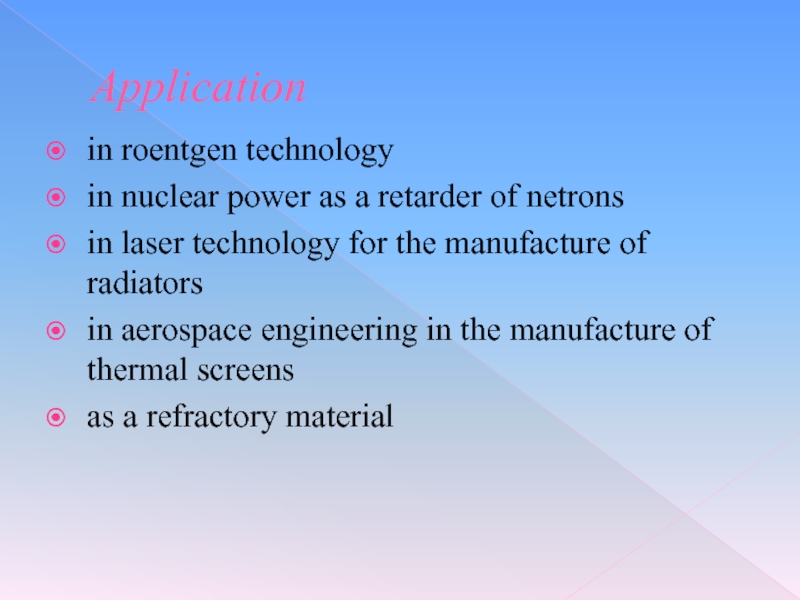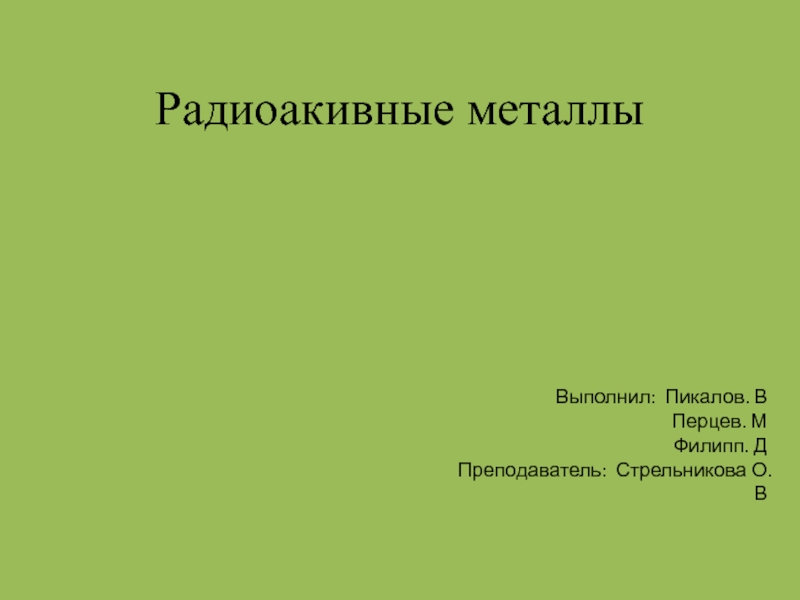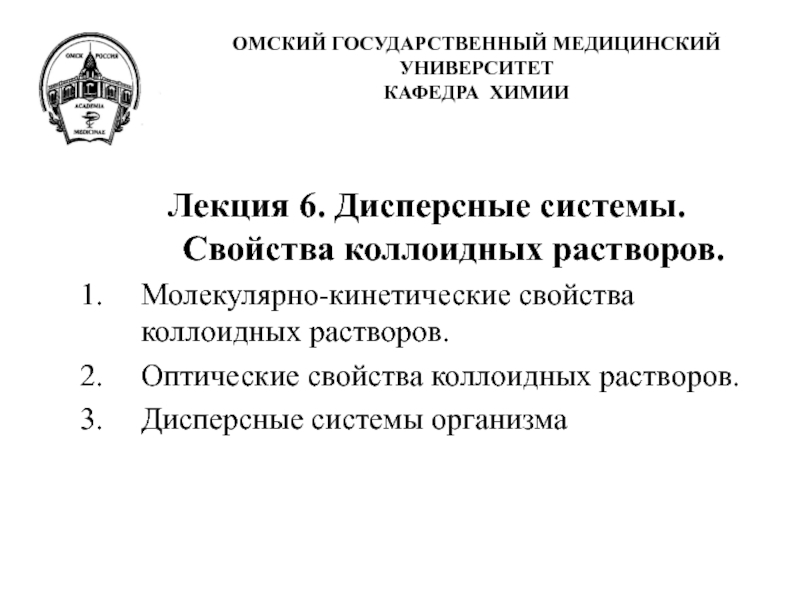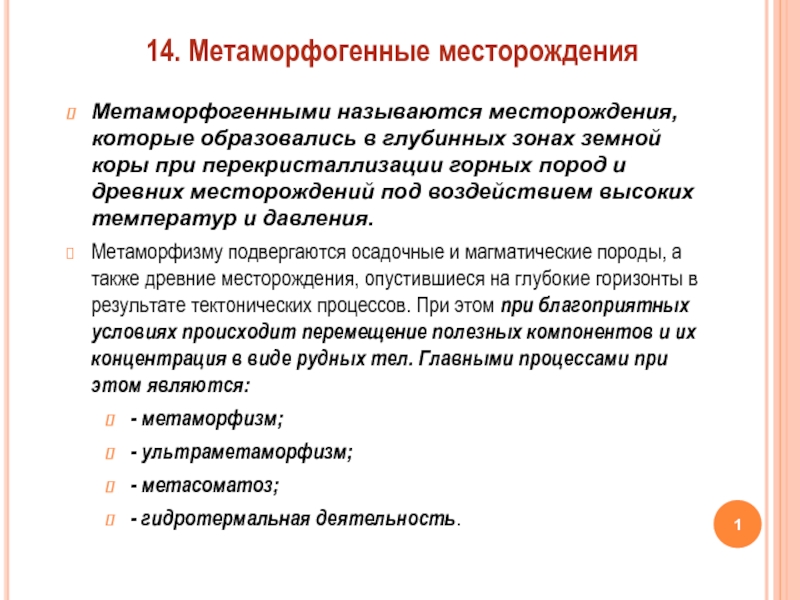- Главная
- Разное
- Дизайн
- Бизнес и предпринимательство
- Аналитика
- Образование
- Развлечения
- Красота и здоровье
- Финансы
- Государство
- Путешествия
- Спорт
- Недвижимость
- Армия
- Графика
- Культурология
- Еда и кулинария
- Лингвистика
- Английский язык
- Астрономия
- Алгебра
- Биология
- География
- Детские презентации
- Информатика
- История
- Литература
- Маркетинг
- Математика
- Медицина
- Менеджмент
- Музыка
- МХК
- Немецкий язык
- ОБЖ
- Обществознание
- Окружающий мир
- Педагогика
- Русский язык
- Технология
- Физика
- Философия
- Химия
- Шаблоны, картинки для презентаций
- Экология
- Экономика
- Юриспруденция
Beryllium презентация
Содержание
- 1. Beryllium
- 2. Lecture plan General characteristic of beryllium Occurrence
- 3. Beryllium Beryllium was first discovered
- 4. Beryllium is located in the Periodic table
- 5. Beryllium is a steel gray
- 6. Occurrence The Sun has a concentration of
- 7. Minerals of Beryllium Red Beryl Emerald Aquamarine White beryl
- 8. Chrysoberyl Phenakit Heliodorous Morganite
- 9. Preparation Friedrich Wöhler and Antoine Bussy independently isolated beryllium
- 10. Chemical properties The chemical properties of beryllium
- 11. Beryllium reacts with diluted H2SO4 and HNO3
- 12. Beryllium reacts with nonmetals and several compounds
- 13. Since beryllium is an amphoteric metal it
- 14. Compounds Beryllium oxide Beryllium oxide,
- 15. Beryllium hydroxide Beryllium hydroxide, Be(OH)2, is an amphoteric hydroxide,
- 16. With acids, beryllium salts are formed.[For example,
- 17. Beryllium sulphide Beryllium sulphide is a chemical
- 18. Beryllium sulphide reacts with hot solutions of
- 19. Application in roentgen technology in nuclear power
- 20. Thank you for the attention
Слайд 2Lecture plan
General characteristic of beryllium
Occurrence
Preparation of beryllium
Physical properties of beryllium
Chemical properties
of beryllium
Compounds
Application
Compounds
Application
Слайд 3Beryllium
Beryllium was first discovered in 1794 by french chemists
Nicholas Vauquelin.The name beryllium comes from the name of beryl mineral.
Слайд 4Beryllium is located in the Periodic table in the second A
group and the second period. Beryllium the first member of group 2A. Beryllium is a chemical element with symbol Be and atomic number 4.
It’s electron configuration is
+4 Be 1s² 2s²
It’s electron configuration is
+4 Be 1s² 2s²
Слайд 5 Beryllium is a steel gray and hard metal that is brittle
at room temperature and has a close-packed hexagonal crystal structure.
It melts at 1258ºC, boils at 2970ºC and has a density of 1,848 g/cm³.
It is has one stable isotop: 9Be
It melts at 1258ºC, boils at 2970ºC and has a density of 1,848 g/cm³.
It is has one stable isotop: 9Be
Слайд 6Occurrence
The Sun has a concentration of 0.1 parts per billion of beryllium. Beryllium
has a concentration of 2 to 6 parts per million in the Earth's crust. Beryllium is found in over 100 minerals,but most are uncommon to rare. The more common beryllium containing minerals include:
bertrandite (Be4Si2O7(OH)2)
beryl (Al2 [Be3(Si6O18)]
chrysoberyl (Al2BeO4)
phenakite (Be2SiO4).
bertrandite (Be4Si2O7(OH)2)
beryl (Al2 [Be3(Si6O18)]
chrysoberyl (Al2BeO4)
phenakite (Be2SiO4).
Слайд 9Preparation
Friedrich Wöhler and Antoine Bussy independently isolated beryllium in 1828 by the chemical reaction of
metallic potassium with beryllium chloride, as follows:
BeCl2 + 2 K → 2 KCl + Be
At the present time beryllium is obtained by reducing beryllium fluoride with magnesium:
BeF+Mg → Be + MgF2
BeCl2 + 2 K → 2 KCl + Be
At the present time beryllium is obtained by reducing beryllium fluoride with magnesium:
BeF+Mg → Be + MgF2
Слайд 10Chemical properties
The chemical properties of beryllium are very similar to aluminium.
It has only +2 oxidation number in it’s compounds. Metallic beryllium is relatively little reactive at room temperature. In a compact form it doesn’t react with water.
Слайд 11Beryllium reacts with diluted H2SO4 and HNO3 solutions.
Be+ H2SO4 (dil) →BeSO4+H2↑
3Be+
8HNO3 (dil) → 3Be(NO3) 2 + 4H2O+2NO
Beryllium also can be affected by concentrated H2SO4 and HNO3
Be+2H2SO4 (conc) →BeSO4+2H2O+SO2
Be +4HNO3 (conc) →Be(NO3) 2+2H2O+2NO2
Beryllium also can be affected by concentrated H2SO4 and HNO3
Be+2H2SO4 (conc) →BeSO4+2H2O+SO2
Be +4HNO3 (conc) →Be(NO3) 2+2H2O+2NO2
Слайд 12Beryllium reacts with nonmetals and several compounds at high temperature:
2Be+O2 →
2BeO
Be+N2 650º C →Be3N2
Beryllium forms binary compounds with many non-metals. Anhydrous halides are known for F, Cl,Br and I:
Be+F2 → BeF2
Be+Cl2 → BeCl2
Be+Br2 → BeBr2
Be+I2 → BeJ2
Be+N2 650º C →Be3N2
Beryllium forms binary compounds with many non-metals. Anhydrous halides are known for F, Cl,Br and I:
Be+F2 → BeF2
Be+Cl2 → BeCl2
Be+Br2 → BeBr2
Be+I2 → BeJ2
Слайд 13Since beryllium is an amphoteric metal it also reacts with strong
bases and liberates H2 gas
Be+NaOH → Na2BeO2+H2 ↑
Be +2NaOH+2H2O → Na2 [Be(OH) 4] +H2 ↑
Be+NaOH → Na2BeO2+H2 ↑
Be +2NaOH+2H2O → Na2 [Be(OH) 4] +H2 ↑
Слайд 14Compounds
Beryllium oxide
Beryllium oxide, BeO, is a white refractory solid, which has
the wurtzite crystal structure and a thermal conductivity as high as in some metals. BeO is amphoteric.
BeO+ 2HCl (conc) → BeCl2+H2O
BeO+ 2NaOH (conc) +H2O →Na2[Be(OH) 4]
BeO+ 2HCl (conc) → BeCl2+H2O
BeO+ 2NaOH (conc) +H2O →Na2[Be(OH) 4]
Слайд 15Beryllium hydroxide
Beryllium hydroxide, Be(OH)2, is an amphoteric hydroxide, dissolving in both acids and alkalis. Industrially, it
is produced as a by-product in the extraction of beryllium metal from the ores beryl and bertrandite.
With alkalis it dissolves to form the tetrahydroxidoberyllate anion.With sodium hydroxide solution:
2NaOH(aq) + Be(OH)2(s) → Na2Be(OH)4(aq)
With alkalis it dissolves to form the tetrahydroxidoberyllate anion.With sodium hydroxide solution:
2NaOH(aq) + Be(OH)2(s) → Na2Be(OH)4(aq)
Слайд 16With acids, beryllium salts are formed.[For example, with sulfuric acid, H2SO4, beryllium sulfate is
formed:
Be(OH)2 + H2SO4 → BeSO4 + 2H2O
Beryllium hydroxide dehydrates at 400 °C to form the soluble white powder, beryllium oxide:
Be(OH)2 → BeO + H2O
Be(OH)2 + H2SO4 → BeSO4 + 2H2O
Beryllium hydroxide dehydrates at 400 °C to form the soluble white powder, beryllium oxide:
Be(OH)2 → BeO + H2O
Слайд 17Beryllium sulphide
Beryllium sulphide is a chemical compound with the formula BeS.
It is a white crystalline substance.
Beryllium sulphide is slowly hydrolyzed by cold water, in hot water the reaction proceeds quickly:
BeS+H2O → Be(OH) 2+H2S
Diluted acids decompose beryllium sulfide with the release of hydrogen sulfide:
BeS+H2Cl (dil) →BeCl2 + H2S
BeS+H2SO4 (dil) → BeSO4 +H2S
Beryllium sulphide is slowly hydrolyzed by cold water, in hot water the reaction proceeds quickly:
BeS+H2O → Be(OH) 2+H2S
Diluted acids decompose beryllium sulfide with the release of hydrogen sulfide:
BeS+H2Cl (dil) →BeCl2 + H2S
BeS+H2SO4 (dil) → BeSO4 +H2S
Слайд 18Beryllium sulphide reacts with hot solutions of alkali and alkali metal
carbonates:
BeS+4NaOH →Na2 [Be(OH) 4]+Na2S
BeS +2Na2CO3+H2O →Na2 [Be(OH)6 ]+ Na2S+CO2
Halogens, with the exception of iodine (which does not react with beryllium sulphide) form halides in the interaction with BeS:
BeS+Cl2 → BeCl2+S
BeS+4NaOH →Na2 [Be(OH) 4]+Na2S
BeS +2Na2CO3+H2O →Na2 [Be(OH)6 ]+ Na2S+CO2
Halogens, with the exception of iodine (which does not react with beryllium sulphide) form halides in the interaction with BeS:
BeS+Cl2 → BeCl2+S
Слайд 19Application
in roentgen technology
in nuclear power as a retarder of netrons
in laser
technology for the manufacture of radiators
in aerospace engineering in the manufacture of thermal screens
as a refractory material
in aerospace engineering in the manufacture of thermal screens
as a refractory material

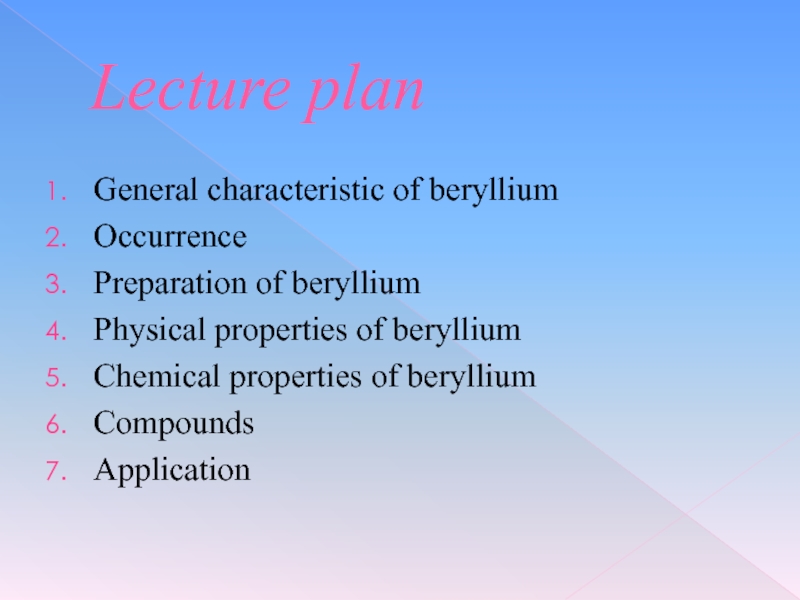
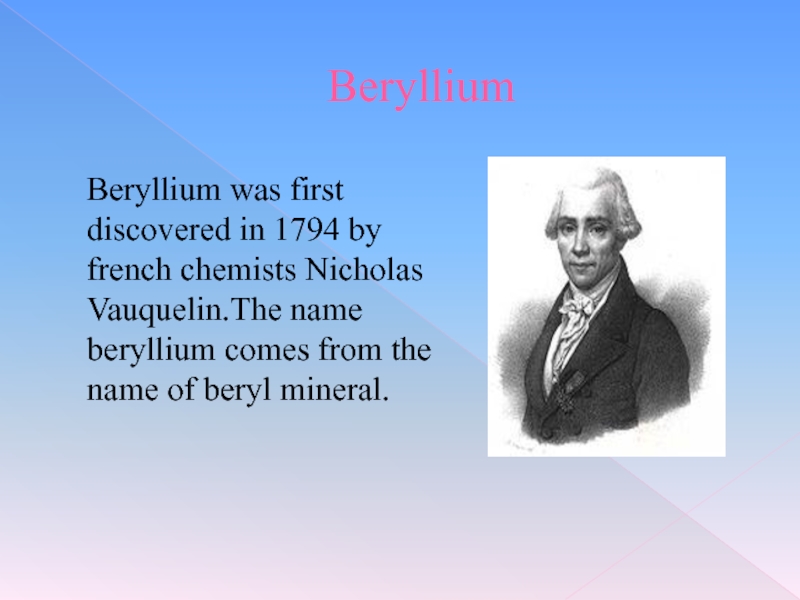
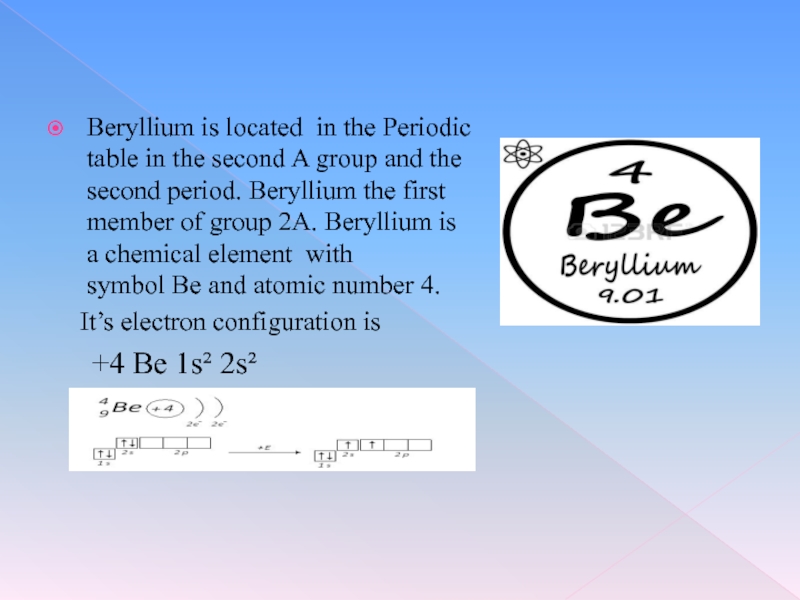

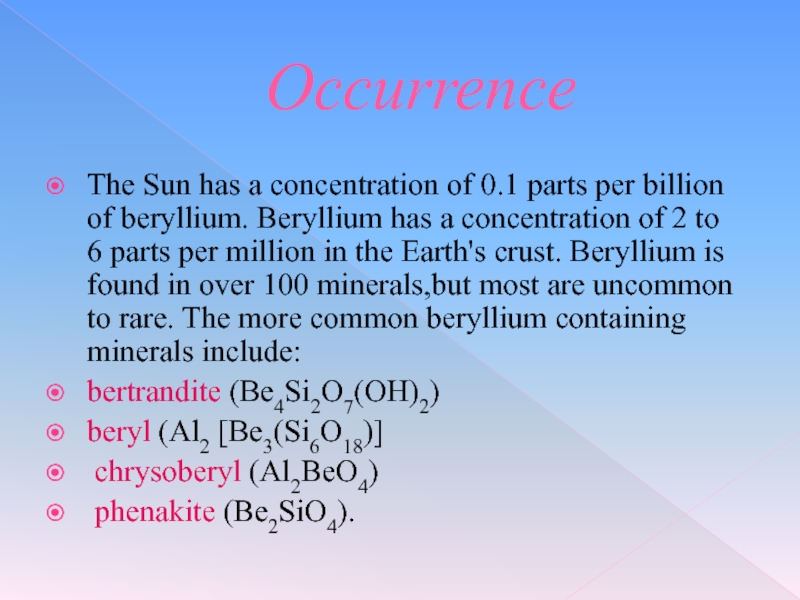

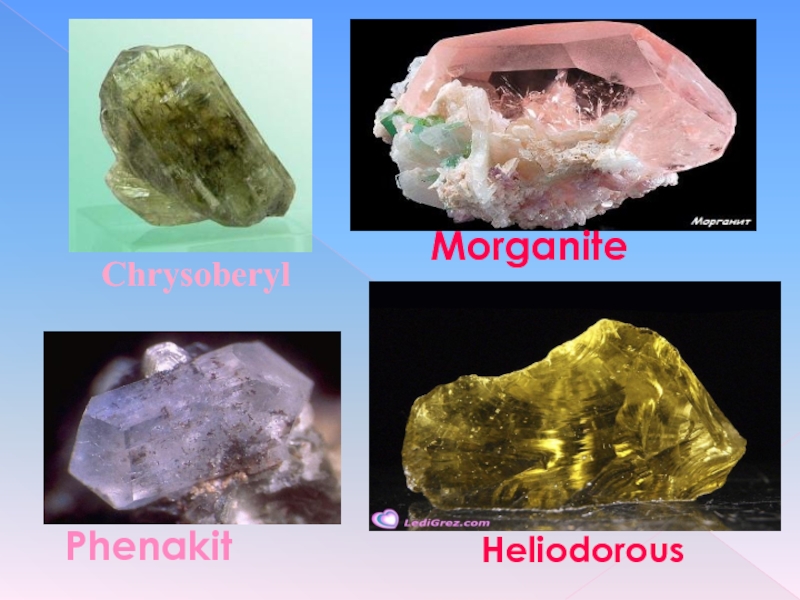
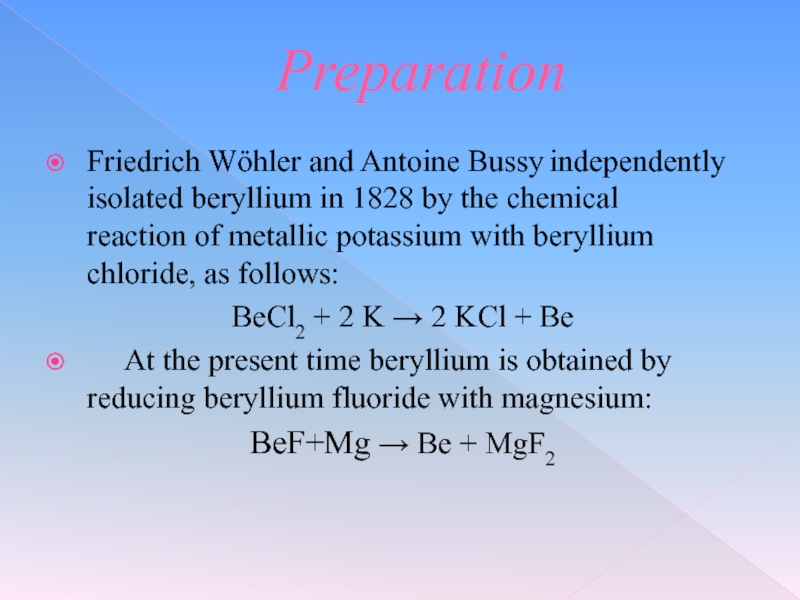

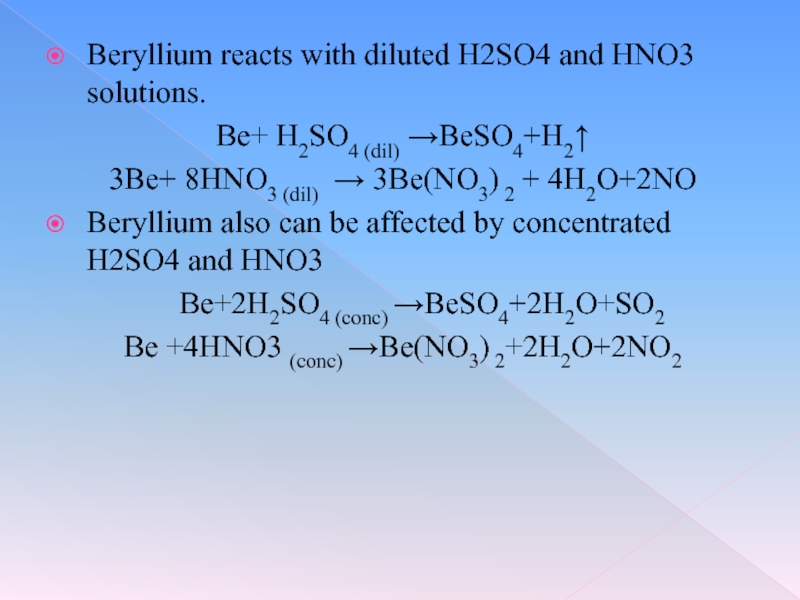
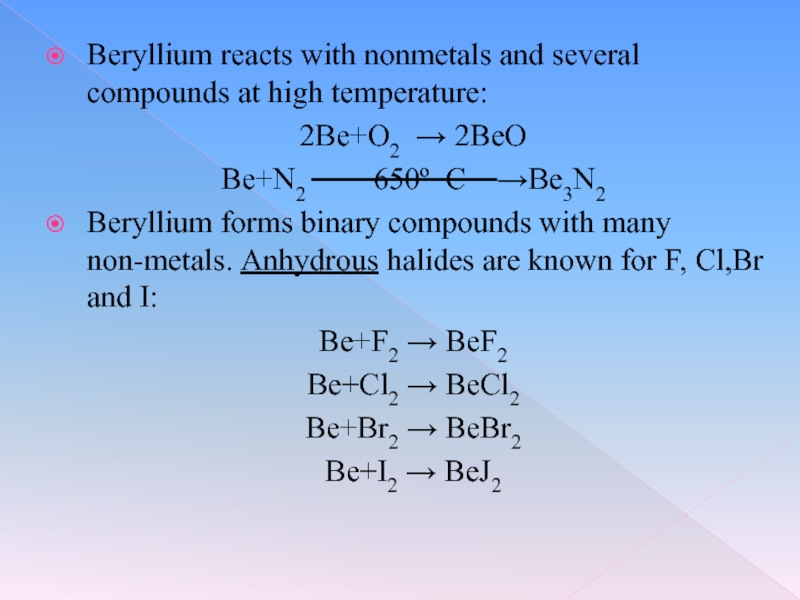

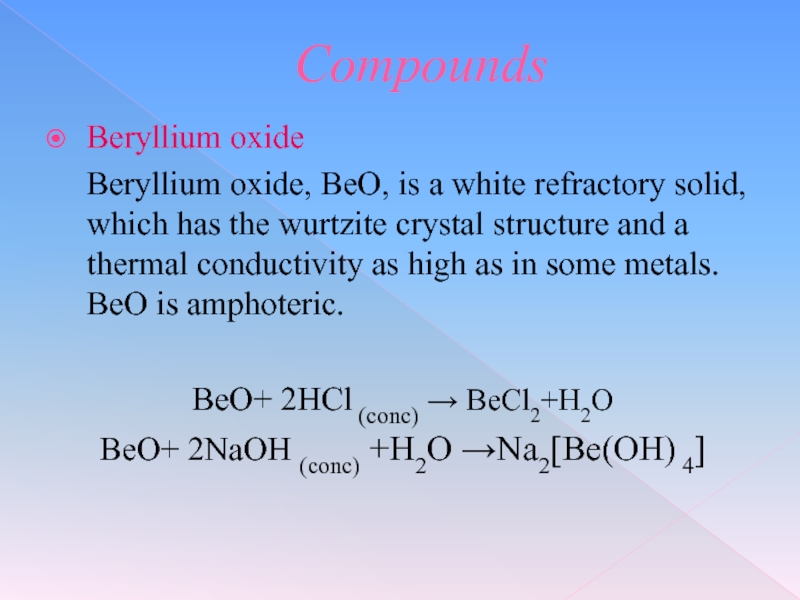
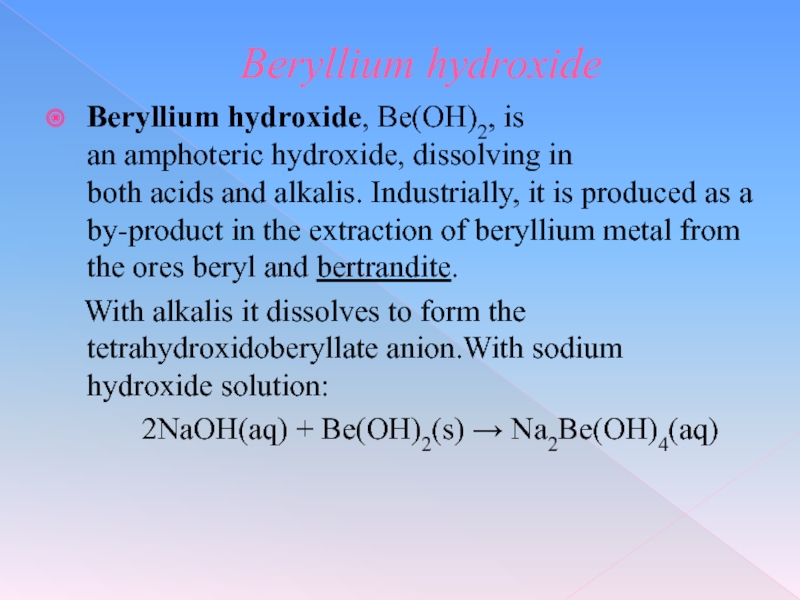
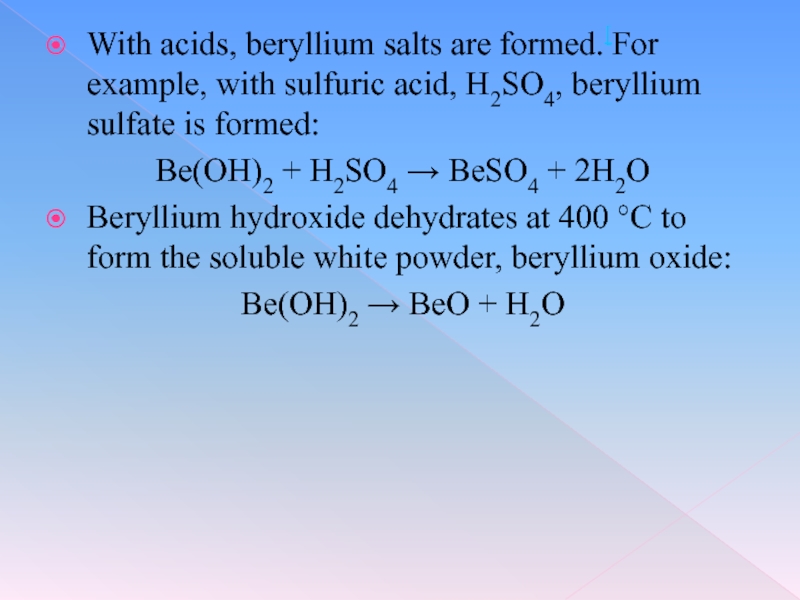
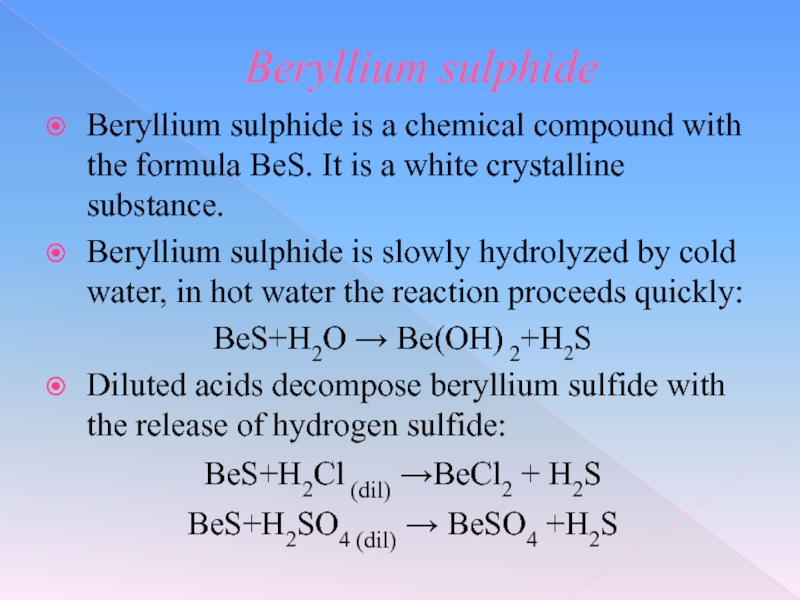
![Beryllium sulphide reacts with hot solutions of alkali and alkali metal carbonates:BeS+4NaOH →Na2 [Be(OH) 4]+Na2SBeS](/img/tmb/5/451532/ddc272010f12cdd17ca28118361297b0-800x.jpg)
